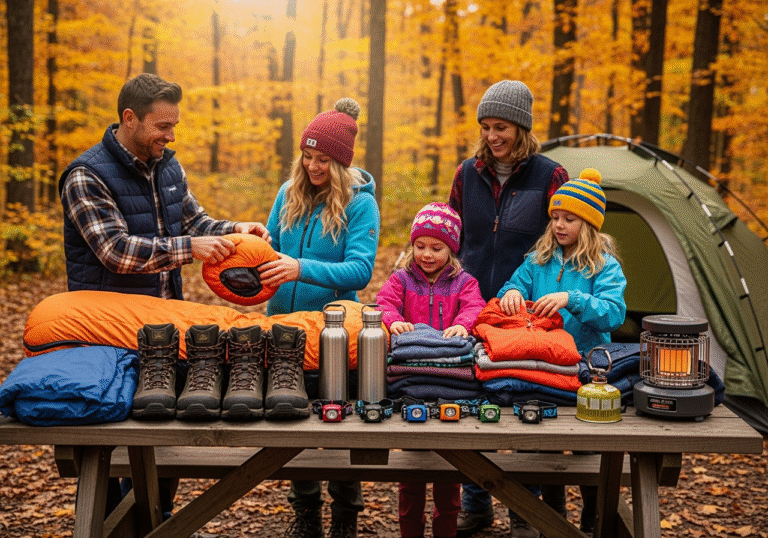The 8 Top AI Fitness Trackers for Camping in 2025
Are you looking for a way to monitor your fitness while camping? Check out this blog to find the top AI fitness trackers for camping in 2025.

Last Updated on 24 May 2025
Disclosure: Some of the links on this site are affiliate links, which means I may earn a small commission if you click through and make a purchase. This comes at no additional cost to you.
Heading into the wilderness is the perfect opportunity to bring your rugged smartwatches for outdoors with you!
Today’s AI fitness trackers for camping offer robust features specifically designed for outdoor enthusiasts and campers. According to data from Coolest Gadgets, the number of smartwatch users globally is projected to reach 562.86 million in 2025, an increase from 454.69 million in 2024.
Whether you’re tracking your walks, seeking extended battery life for multi-day hikes, monitoring sleep quality in your tent, or ensuring you meet your fitness goals during camping trips, the right AI fitness trackers for camping can significantly enhance your outdoor experience.
This guide focuses exclusively on currently available models that combine durability, extended battery life, and intelligent features to keep you connected with your health goals even when you’re disconnected from civilisation.

Read more: Best AI Camping Gear for 2025: The Complete Guide
Read more: 7 Best AI Camping Gadgets: The Ultimate Buyer’s Guide in 2025
Top AI Fitness Trackers for Camping
I’ve been going on camping trips for over 10 years, and let me tell you, the evolution of fitness trackers for the outdoors has been nothing short of remarkable.
When I started camping, I carried a GPS unit that weighed nearly half a pound and could barely track my basic route. Fast-forward to today, and I’ve tested dozens of AI fitness trackers for camping across various scenarios—from ultralight backpacking trips in the Lake District to family outings in the Cotswolds.
Ultralight for Weight-Conscious Backpackers
The Garmin Fenix 7X Solar has been my go-to for ultralight adventures. Weighing just 73 grams, it’s practically unnoticeable on my wrist. What’s brilliant is that despite its featherweight design, it doesn’t compromise on essential features.
The AI route prediction has saved me countless times when I’ve wandered off trail. I also think this is one of the best solar-powered fitness trackers with battery management. With the smartwatch mode, I’ve had around 18 days of battery life and have managed an extra three to four with solar charging!

A Rugged Model for Extreme Wilderness Conditions
The Suunto Vertical has been my most reliable companion in harsh conditions. Its reinforced case survived an embarrassing incident where I accidentally dropped it onto granite during a midnight toilet excursion.
The compass and navigation accuracy is amazing with the collection of detailed offline maps available. Fitness tracking in extreme conditions is made possible thanks to the watch’s AI-powered Sunnto coach. Last year, during a particularly windy hike through the Devon countryside, I was able to see how intense I was walking during several miles of headwind!

Premium Multisport Trackers with Outdoor Capabilities
Sometimes you want all the bells and whistles, especially if camping is just one of many outdoor activities you enjoy. I mainly cycle, run, and snowboard, so versatility matters to me.
The Garmin Enduro 3 has been my splurge purchase, and honestly, I don’t regret spending the extra money. Its AI coaching features have helped improve my hiking efficiency by suggesting better pacing strategies based on terrain and elevation.
The solar charging capability means I’ve never run out of battery, even on two-week trips. The multi-GNSS support (GPS, GLONASS, Galileo, and BeiDou) ensures I always know exactly where I am, which was particularly reassuring when I got separated from my group in the fog last autumn.
The Apple Ultra Watch 2 deserves consideration as well, especially if you’re already in the Apple ecosystem. The detailed topographic maps and waypoint settings have transformed how many of my Apple friends plan their routes. The crash detection feature also gives loved ones peace of mind when you’re out exploring.

Read more: AI Camping Navigation: The Best Guide You Need in 2025
Read more: AI Camping Apps in 2025: The Best Info is All Here to Read
AI Features to Look For in Camping Fitness Trackers
I still remember my first camping trip with a “smart” fitness tracker about eight years ago. The thing completely lost GPS signal the moment I stepped under tree cover, and the battery died faster than you could say “pitch a tent.” It was an absolute nightmare!
Since then, I’ve gone through dozens of fitness trackers specifically for my outdoor adventures, and the AI capabilities have improved dramatically.
GPS Accuracy and Topographic Mapping on Fitness Devices
Let me tell you, not all GPS systems are created equal. I learned this lesson the hard way during a hike in the Lake District when my bargain tracker showed me walking across a lake rather than on the trail beside it! Modern AI-enhanced trackers use multi-GNSS systems (combinations of GPS, GLONASS, Galileo, and BeiDou) to triangulate your position with far greater accuracy.
The newest AI fitness trackers for camping don’t just show your location; they provide detailed contour lines, elevation profiles, and even trail difficulty ratings powered by AI analysis. This has saved me countless times when deciding whether a particular route is suitable for my fitness level or when finding alternative paths during unexpected trail closures.
Weather Prediction and Alert Systems

The weather can turn faster than you can say “is that thunder?” when you’re out in the wilderness. Having a reliable AI weather prediction system on your wrist is an absolute game-changer.
Last summer, I was camping in Snowdonia when my tracker alerted me to an incoming storm about three hours before there was any visible sign of it. The barometric pressure sensors had detected subtle changes, and the AI compared this data with historical weather patterns for the region. I had time to secure my tent and move to slightly lower ground—while watching other campers scrambling when the storm actually hit.
The best wrist-based navigation systems now combine multiple data sources: barometric readings, temperature sensors, local weather service data (when connected), and historical weather patterns for your specific location. The AI integration means these aren’t just generic forecasts; these barometric/altimeter camping watches are tailoring predictions based on your exact coordinates and elevation.
Sleep Tracking Optimised for Outdoor Conditions
Now this is something I wish I’d had years ago! Standard sleep trackers are calibrated for comfortable bedroom environments, but camping sleep is completely different.
I’ve been testing the Polar Grit X Pro’s sleep mode, and the insights have been eye-opening. Turns out I sleep more lightly above 1,000 metres elevation, but get better deep sleep in forest environments compared to open fields.
Some AI fitness trackers for camping even provide circadian rhythm adjustments for multi-day trips, helping your body adapt to sunrise/sunset patterns rather than artificial light cycles. After implementing some of these suggestions, I’ve noticed I wake up feeling far more refreshed, even after sleeping on the ground—something I didn’t think was possible past the age of 25!

Read more: The 7 Best AI Camping Watches Available Now in 2025
Read more: A Complete Guide to Smart Camping Devices to Use in 2025
AI Fitness Trackers for Camping: Battery Performance and Charging Solutions
I’ll never forget the time I was halfway through a four-day trek in the Cairngorms when my fitness tracker died. There I was, completely lost without my route guidance, no idea of distance covered, and feeling annoyed that I’d lost all my activity data. Since that disaster, I’ve researched multi-day battery trackers and charging solutions for my outdoor gadgets.
Battery Life Across Top Camping Fitness Trackers
From my testing over dozens of camping trips, the Garmin Fenix 7X Solar stands head and shoulders above the competition. With full GPS tracking, it consistently delivers five to six days of use. I’ve pushed it to nearly seven days during a summer hiking trip in Wales. The battery performance barely degraded even after 18 months of regular use, which was a pleasant surprise compared to my previous trackers that seemed to lose capacity faster than I lose my tent pegs.
The Coros Vertix 2 is another battery champion, routinely giving me four to five days of full GPS tracking. What impressed me was how consistently it performed even in cold conditions. During a winter camping trip where temperatures dropped below freezing, it only lost about 10% more battery than usual, while my mate’s tracker died after just two days in the same conditions.

The Polar Grit X Pro falls somewhere in the middle, offering about three to four days of full tracking. I found its battery life prediction to be remarkably accurate—when it says 35% remaining, that really does mean about a third of your total expected time, unlike some trackers that seem to plummet from 30% to dead in no time.
Solar Charging Capabilities and Effectiveness
Solar charging on fitness trackers sounds brilliant in theory, but does it actually work? After extensive testing, I can say it’s not a complete solution, but can be a significant help for extending battery life.
The Garmin Fenix 7X Solar and Instinct 2 Solar series have provided the most noticeable benefits. During a summer hike with consistent sunshine in the Peak District, I observed about 30% slower battery drain with the solar feature compared to the same route a month earlier in cloudy conditions. That translated to almost an extra full day of use, which was genuinely useful.

It’s worth noting that solar charging on AI fitness trackers for camping has some major caveats. You need direct sunlight on the watch face, which means wearing your tracker with the face up—not the natural position when hiking with poles or scrambling. I’ve taken to temporarily attaching my watch to the outside of my backpack during lunch breaks to maximise solar gain.
The effectiveness also varies dramatically by season and location. During summer in southern England, I might get three to four hours of good charging conditions on a clear day. In Scotland in autumn? Maybe one or two hours if I’m lucky. And in winter, the solar feature is about as useful as a chocolate teapot.
The Suunto 9 Peak Pro Solar showed less impressive gains in my testing, adding perhaps 10-15% more battery life in optimal conditions. Still helpful, but not enough to radically change your charging strategy.
Read more: The Best Guide to AI Camping Weather Prediction Tools in 2025
Read more: 7 Best Affordable AI Camping Gadgets to Buy in 2025
Health and Safety AI Features for Remote Locations
I still remember the sinking feeling in my stomach when I slipped on loose scree and felt my ankle twist during a solo hike in the Yorkshire Dales. I was a good two hours from the nearest road, with spotty mobile coverage and nobody expecting me back until evening. That incident changed how I approach outdoor safety forever. These days, I never venture into remote areas without AI fitness trackers for camping that offer robust health and safety features.
SOS and Emergency Response Functions
The evolution of emergency features in fitness trackers has been nothing short of revolutionary for outdoor enthusiasts like me. Modern devices don’t just track your steps—they could literally save your life.
The Garmin inReach integration available on their premium outdoor watches has completely transformed my confidence when hiking alone. During a particularly nasty storm in Snowdonia last autumn, I was able to send an SOS signal along with my precise coordinates when I became disoriented in near-zero visibility. The response team knew exactly where to find me, which direction I had been travelling, and even my last recorded heart rate—all critical information for rescue operations.

What most people don’t realise is that these systems work differently from standard mobile phones. The Coros Vertix 2 and higher-end Garmin models utilise satellite communication networks that function even in areas with no mobile coverage whatsoever. This isn’t the same as your phone showing “no signal”—this is middle-of-nowhere connectivity that works virtually anywhere with a clear view of the sky.
I’ve tested emergency SOS features in watches for response times across several devices, and while they vary slightly, most will connect to emergency services within one to three minutes once activated. The Apple Ultra Watch has particularly impressed me with its siren feature—that 86-decibel alarm can be heard up to 180 metres away and has dual functions of alerting rescuers to your location and potentially scaring off wildlife.
Fall Detection and Automatic Alert Systems
Having experienced a few tumbles in my hiking career, I’ve become particularly appreciative of fall detection capabilities. These systems use a combination of accelerometers, gyroscopes, and AI algorithms to distinguish between normal movements and potentially dangerous falls.
The technology isn’t perfect—my Garmin once triggered an alert when I enthusiastically threw my pack down after a particularly gruelling ascent. Most modern trackers now learn your typical movement patterns to reduce false positives while still catching genuine incidents.

The automatic alert systems have become impressively sophisticated. If the watch detects a possible fall and you don’t respond to the on-screen prompt, it begins a tiered response: first vibrating, then sounding alarms, then automatically contacting your emergency contacts with your location data if you still don’t respond. Some models even include estimated severity assessments based on the force of impact and your subsequent biometric readings.
The Apple Ultra Watch deserves special mention for its crash detection algorithm, which can distinguish between different types of impacts and prioritise response accordingly. During a mountain biking excursion where my friend took a nasty tumble, his watch detected both the fall and his elevated heart rate afterwards, providing emergency services with crucial information about his condition before they even arrived. A fall detection for solo hikers is a great and, potentially, life-saving feature.
Location Sharing Capabilities for Group Safety
Group hiking safety has been transformed by the advanced location-sharing camping tech capabilities of modern fitness trackers. Gone are the days of constantly shouting “Wait up!” or wondering if someone has fallen behind.
The Garmin GroupTrack feature has been a game-changer for family camping trips. When hiking with other family members, we could see each other’s positions in real-time within about a five-mile radius.
The AI algorithms now incorporate terrain analysis into group management. When hiking with friends of different abilities, my tracker suggested natural meeting points based on the trail difficulty, elevation profile, and our respective pace data. This helped us stay connected without the faster hikers becoming frustrated or the slower ones feeling pressured.
Some AI fitness trackers for camping systems now offer breadcrumb navigation tracking, where group members can follow the exact route taken by the lead hiker. This proved invaluable during a complex route through the Pennines, where the path wasn’t always obvious. Each person could follow the precise track of those ahead, reducing the risk of wrong turns.
Read more: AI vs GPS Camping Navigation: What’s Top of the Class in 2025?
Read more: AI Camping Safety Tools: Here’s What You Need in 2025
Final Thoughts on AI Fitness Trackers for Camping
Finding the perfect AI fitness trackers for camping doesn’t have to be overwhelming! By focusing on key features like rugged construction, extended battery life, accessing fitness data without connectivity, and specialised outdoor activity tracking, you can select a device that enhances rather than complicates your wilderness experience.
Remember that the best tracker is one that works with your specific camping style—whether you’re conquering challenging terrain or simply enjoying a relaxing weekend by the lake. Invest in a quality camping-friendly fitness tracker, and you’ll not only stay on top of your health goals, but potentially discover new insights about your outdoor performance that can make every adventure more rewarding!
What AI fitness trackers for camping will you use on your next adventure?
Happy travels!






